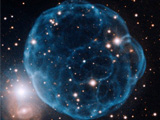|
|
TODAY.AZ / Weird / Interesting
Amateur astronomer discovers blue-raspberry-shaped planetary nebula
27 July 2011 [11:46] - TODAY.AZ
 Combing through the night sky and looking for possible planetary nebulae is tough, tedious work. NASA actually works with several amateur astronomy groups to examine the findings from its Kepler space observatory, so sometimes, the big discoveries are made by amateurs--including this one, the newest known planetary nebula, named Kronberger 61.
Combing through the night sky and looking for possible planetary nebulae is tough, tedious work. NASA actually works with several amateur astronomy groups to examine the findings from its Kepler space observatory, so sometimes, the big discoveries are made by amateurs--including this one, the newest known planetary nebula, named Kronberger 61.This image, provided by the Gemini Observatory, shows the "ionized shell of expelled gas," colored blue due to the double-ionization of the oxygen. If you look closely, you can see the star at the center of the system--it's the bright bluish dot near the center of the blue-raspberry-like shell.
The Kepler mission's goal is to find Earth-like planets, so the discovery of a new planetary nebula opens up the possibility for some exciting new discoveries. It'll take a lot more examination to find out if there are any "Goldlocks planets," close enough but not too close to a star to foster the kind of life we have on Earth, but the discovery certainly opens the door for that kind of study.
The star was discovered by, and named for, an amateur Austrian astronomer named Matthias Kronberger, who works with a group of other amateurs known as Deep Sky Hunters.
/Popular Science/
URL: http://www.today.az/news/interesting/91458.html
 Print version
Print version
Views: 1816
Connect with us. Get latest news and updates.
See Also
- 19 February 2025 [22:20]
Visa and Mastercard can return to Russia, but with restrictions - 05 February 2025 [19:41]
Japan plans to negotiate with Trump to increase LNG imports from United States - 23 January 2025 [23:20]
Dubai once again named cleanest city in the world - 06 December 2024 [22:20]
Are scented candles harmful to health? - 23 November 2024 [14:11]
Magnitude 4.5 earthquake hits Azerbaijan's Lachin - 20 November 2024 [23:30]
Launch vehicle with prototype of Starship made its sixth test flight - 27 October 2024 [09:00]
Fuel prices expected to rise in Sweden - 24 October 2024 [19:14]
Turkiye strikes terror targets in Iraq and Syria - 23 October 2024 [23:46]
Kazakhstan supplied almost entire volume of oil planned for 2024 to Germany in 9 months - 23 October 2024 [22:17]
Taiwan reported passage of Chinese Navy aircraft carrier near island
Most Popular
 Separatists & Pashinyan - the farce continues
Separatists & Pashinyan - the farce continues
 4SIM signs MoUs with Chinese institutions to boost cooperation in green and industrial technologies
4SIM signs MoUs with Chinese institutions to boost cooperation in green and industrial technologies
 Collapse of "macaronism": Resignation of the "grey cardinal" of France may cause a chain reaction
Collapse of "macaronism": Resignation of the "grey cardinal" of France may cause a chain reaction
 Paris hosts debut of Azerbaijan’s first AI art “Shusha”
Paris hosts debut of Azerbaijan’s first AI art “Shusha”
 Foreign diplomats tour liberated cities of Khankendi and Shusha
Foreign diplomats tour liberated cities of Khankendi and Shusha
 Khojaly victim testifies at Baku Military Court: “Madat Babayan’s gang tortured me”
Khojaly victim testifies at Baku Military Court: “Madat Babayan’s gang tortured me”
 Somalian minister praises Türkiye’s role in peace and development
Somalian minister praises Türkiye’s role in peace and development
